Path of Exile beginners guide: Tips and tricks to get you started on the path back from exile

Path of Exile is a free to play Diablo-style action-RPG with seven playable character classes and lots of deep gameplay mechanics. This guide will explain the basic systems and offer plenty of helpful tips to get you started on your quest to return from exile!
Find the starting character that's right for you

Path of Exile has seven playable characters, although only six are initially unlockable. The seventh, the Scion, can be permanently unlocked by rescuing her from a cage in the Upper Scepter of God area of Act 3.
- Duelist: He fights with melee attacks and can also summon an AI minion to fight alongside him.
- Templar: Fires projectiles, including three balls of lightning at once and a chain lightning attack.
- Witch: A female spellcaster with high intelligence.
- Ranger: She uses a bow and is extremely dexterous, but can wield swords as well. Despite being a glass cannon, the ranger is my class of choice.
- Marauder: A melee fighter with tremendous strength.
- Shadow: A dexterous and intelligent fighter, he uses short-range weapons and traps during battle.
- Scion: She can develop into any character build thanks to Path of Exile's skill system. This makes her an advanced character, and she must be unlocked later in the game.
Picking your first character is important, but not as big a deal as in other Diablo-style games. Path of Exile provides an unusually high number of character slots, so you can play and switch between all seven classes if you so choose. Also, the time-limited nature of leagues (which we'll describe below) and the likelihood that you might unwittingly create a flawed character build the first time you play all mean that you'll probably be creating new characters before too long anyway.
Follow a character build, but don't sweat it if you're making your own way

Many players prefer to create their own unique character build the first time they play, experimenting with different passive skills. But if you do that, keep in mind that full-character respecs are not an option in Path of Exile. You'll earn a limited number of respec points through natural progression and grinding, but not so many that quickly transforming one build to another is a viable option.
Thus, my advice is to follow a well-regarded build created by experienced players. This will focus your character growth and ensure that you have an endgame viable character when the time comes. Here are some quick beginner-friendly build recommendations (current as of launch):
- Duelist: Sweep or Die by Chayman
- Templar: Quad Glacial Cascade Totems by Weallgotissues
- Witch: Whaitiri's Arc Witch
- Ranger: NeverSink's In-depth Tornado and Archer Guide
- Marauder: Double Strike Tank Guide by ShihanPiotr
- Shadow: Say_Ten's Melee Shadow
- Scion: Dark Pact Self-Cast Ascendant by Zarasi

If you're making up your own build, be sure you understand these features of the passive skill tree:
- Starting Areas: Your character starts with points in a certain area, but you can also feel free to work towards other classes' nodes.
- Paths: Much of the skill three consists of paths that offer a +10 bonus to one of the three core stats. Try to pick up the stat you need as you work towards other features on the tree.
- Clusters: Groups of similarly themed nodes, often with an icon in the center of them. Clusters come in many sizes and often have a gold-colored skill that is especially powerful and desirable.
- Keystones: Unique nodes that change the balance of game mechanics for your character. Each one has an amazing buff but also a significant penalty to consider.
Join the league that best meets your needs
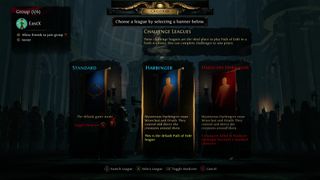
Leagues are game world variations that affect how the game plays. There are several types of leagues, although not every type is available at all times. These include:
Get the Windows Central Newsletter
All the latest news, reviews, and guides for Windows and Xbox diehards.
- Standard: The basic game without any modifications. Despite the name, standard is not the most populated league.
- Hardcore: Standard and other league variants can be played in Hardcore as well. This challenges players to complete the game without dying. Should you die, your character will be demoted to the standard league. Note that hardcore leagues are less populated than non-hardcore leagues, and thus make it harder to group up and trade with other players. There are currently no Xbox Achievements for completing the game on hardcore, so only play hardcore if you really want the challenge.
- Challenge: These offer special prizes for completing league-specific challenges, with numerous challenges available to go after. These are generally available for three months, after which point any characters created for the challenge league will be moved to the standard league.
- Solo Self Found: These league variants lock the game to single player, preventing all trading and grouping. Naturally, this increases the challenge. Solo Self Found leagues are not available on Xbox One at launch.
Even though standard sounds like the default mode, it isn't. Path of Exile players generally concentrate on the current challenge league. Thus, you'll want to consider how important difficulty, multiplayer features, and the economy (item trading, etc.) are to you when selecting a league.
Learn the gem system and take advantage of support gems
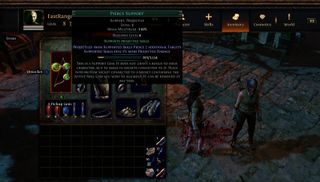
To gain new skills in Path of Exile, you'll usually need to equip gems into sockets in your gear. Any class can use any skill, but gems do have stat and level requirements. Gems can only be equipped in slots of the same color.
There are two types of gems:
- Skill gems: These add an attack, spell, projectile, or trap/mine.
- Support gems: These gems modify supportable skills when equipped in a linked socket (one that has a line drawn to another socket). The support gem must be compatible with the gem in the linked socket in order to have an effect. For instance, a support gem that affects projectiles won't do anything to a linked melee attack gem. Make sure your linked gems are compatible!
Equipped gems also level up as you earn XP, receiving ten percent of the base XP awarded from monster kills. Your character experiences an XP penalty when revisiting lower level areas, but that penalty doesn't apply to gems. Thus you can quickly level gems by replaying areas that are a few levels lower than your current level.
Don't pick up every single piece of loot you find
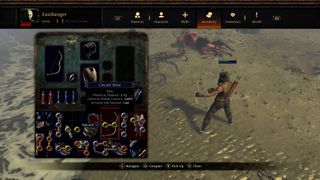
Every piece of loot you acquire takes up varying amounts of space in your bag. To carry as many possible things at once, you have to move items around and squeeze things into the allotted spaces. Even then, your bag is bound to fill up quickly if you pick up every single item you encounter.
The trick, then, is to ignore items that your character can't use or are of low value. Item rarity is indicated by colors:
- White: Normal
- Blue: Magic
- Yellow: Rare
- Orange: Unique
You can pretty much ignore white items unless you're about to head back to town and have the room to spare for them. Rarer items are usually worth picking up and selling, even if you have to hold onto them for a while. And of course, any item that looks better than your current gear is worth grabbing – even if you have to drop something else temporarily while you equip it.
Don't neglect life and mana regeneration
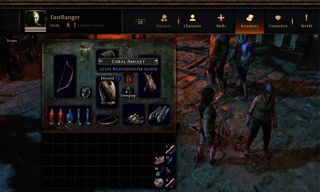
By default, characters don't regenerate life but they do regenerate a tiny amount of mana every second. You can manually refill life and mana by using the appropriate type of flask. Flask charges automatically refill when visiting a town or hideout. They also gain charges from killing enemies. Equipping better flasks increases the amount of life or mana regained, and can have other effects as well.
Still, you'll have a hard time if you only rely on flasks for life and mana. Gear and passive skills can increase regeneration for either stat or even steal life and mana from hits and kills. Considering the life and mana restoring properties of gear is important to keeping your health and mana pool up. At bare minimum, you want to have some life regeneration so you can recover health between battles.
Begin your return from exile
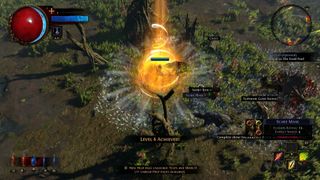
These tips should start you on the path towards returning home and exacting revenge on those who exiled you. One more tip to consider: if you're struggling with the game solo, you can usually invite a friend or player from town to help. Don't take your exile sitting down!
As our review declares, Path of Exile is one of the best Diablo-style action-RPGs around. It won't break the bank either, as it's free to play on Xbox One and Steam. The microtransactions are unusually fair as well, so you don't have to buy anything to succeed. But if you want to support the developers, there are several optional microtransactions – including limited edition premium bundles.
The First Blood Bundle costs $19.99 and includes $20 worth of currency, an extra stash tab, and a weapon effect. The Oriath Supporter Pack costs $29.99 and packs $25 worth of currency, a weapon effect, and a special social frame.
Paul Acevedo is the Games Editor at Windows Central. A lifelong gamer, he has written about videogames for over 15 years and reviewed over 350 games for our site. Follow him on Twitter @PaulRAcevedo. Don’t hate. Appreciate!

